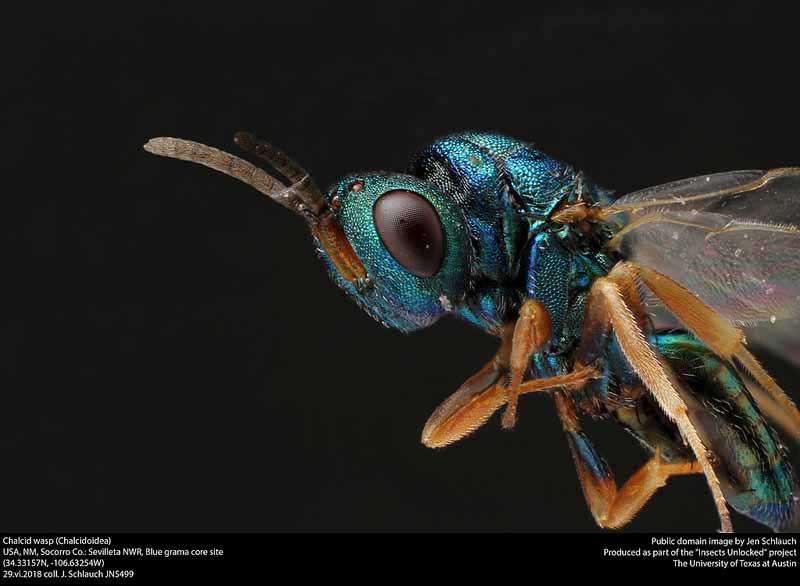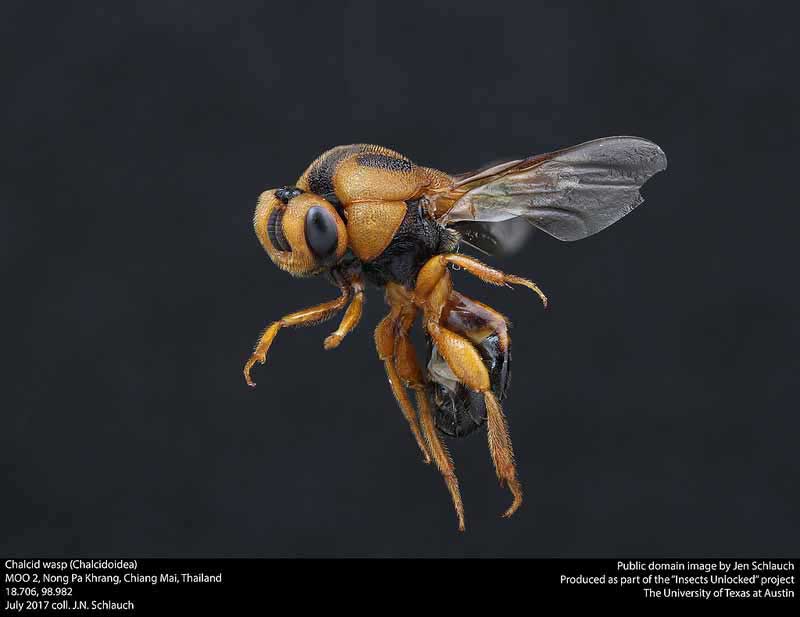
Chalcidoidea sp.
Superregnum: Eukaryota
Cladus: Unikonta
Cladus: Opisthokonta
Cladus: Holozoa
Regnum: Animalia
Subregnum: Eumetazoa
Cladus: Bilateria
Cladus: Nephrozoa
Cladus: Protostomia
Cladus: Ecdysozoa
Cladus: Panarthropoda
Phylum: Arthropoda
Subphylum: Hexapoda
Classis: Insecta
Cladus: Dicondylia
Subclassis: Pterygota
Cladus: Metapterygota
Infraclassis: Neoptera
Cladus: Eumetabola
Cladus: Endopterygota
Superordo: Hymenopterida
Ordo: Hymenoptera
Subordo: Apocrita
Superfamilia: Chalcidoidea
Familiae (22 + 2 extinct): Agaonidae - Aphelinidae - Azotidae - Chalcididae - Cynipencyrtidae - † Diversinitidae - Encyrtidae - Eriaporidae - Eucharitidae - Eulophidae - Eupelmidae - Eurytomidae - † Khutelchalcididae - Leucospidae - Mymaridae - Ormyridae - Perilampidae - Pteromalidae - Rotoitidae - Signiphoridae - Tanaostigmatidae - Tetracampidae - Torymidae - Trichogrammatidae
[source: UCD]
Name
Chalcidoidea Latreille, 1817

References
Ashmead, W.H. 1904: New generic names in the Chalcidoidea. Proceedings of the Entomological Society of Washington 6: 126. BHL Reference page.
Dale-Skey, N., Askew, R.R., Noyes, J.S., Livermore, L. & Broad, G.R. 2016. Checklist of British and Irish Hymenoptera - Chalcidoidea and Mymarommatoidea. Biodiversity Data Journal 4: e8013. DOI: 10.3897/BDJ.4.e8013. Reference page.
Gibson, G.A.P.; Huber, J.T.; Woolley, J.B. 1997: Annotated keys to the genera of Neartic Chalcidoidea (Hymenoptera). National Research Council of Canada.
Hayat, M.; Khan, F.R.; Badruddin, S.M.A. 2011: Type depositories of Chalcidoidea (Hymenoptera) species described from the Department of Zoology, Aligarh Muslim University, India. Zootaxa, 2786: 1–26. Preview
Heraty, J.M., Burks, R.A., Cruaud, A., Gibson, G.A.P., Liljeblad, J., Munro, J., Rasplus, J.-Y., Delvare, G., Janšta, P., Gumovsky, A., Huber, J., Woolley, J.B., Krogmann, L., Heydon, S., Polaszek, A., Schmidt, S., Darling, D.C., Gates, M.W., Mottern, J., Murray, E., Molin, A.D., Triapitsyn, S., Baur, H., Pinto, J.D., Noort, S.v., George, J. & Yoder, M. 2013. A phylogenetic analysis of the megadiverse Chalcidoidea (Hymenoptera). Cladistics 29(5): 466–542. DOI: 10.1111/cla.12006 Reference page.
Munro, J.B. et al. 2011: A molecular phylogeny of the Chalcidoidea (Hymenoptera). PLoS ONE, 6(11): e27023. DOI: 10.1371/journal.pone.0027023
Rameshkumar, A., Poorani, J. & Naveen, V. 2015. Additions to the Encyrtidae and Mymaridae (Chalcidoidea) of India with new distribution and host records for some species. Biodiversity Data Journal 3: e5216. DOI: 10.3897/BDJ.3.e5216 Reference page.
Roskam, J.C. 2013: Biosystematics of insects living in female birch catkins. V. Chalcidoid ectoparasitoids of the genera Torymus Dalman, Aprostocetus Westwood, Psilonotus Walker and Eupelmus Dalman (Hymenoptera, Chalcidoidea). Tijdschrift voor entomologie 156(1): 21-34. DOI: 10.1163/22119434-00002020 Reference page.
Vernacular names
English: Chalcid wasp
日本語: コバチ上科
Chalcid wasps (/ˈkælsɪd/, from Greek khalkos 'copper', for their metallic colour)[1] are insects within the superfamily Chalcidoidea, part of the order Hymenoptera. The superfamily contains some 22,500 known species, and an estimated total diversity of more than 500,000 species, meaning the vast majority have yet to be discovered and described.[2] The name "chalcid" is often confused with the name "chalcidid", though the latter refers strictly to one constituent family, the Chalcididae, rather than the superfamily as a whole; accordingly, most recent publications (e.g.,[2]) use the name "chalcidoid" when referring to members of the superfamily.
Most of the species are parasitoids of other insects, attacking the egg or larval stage of their host, though many other life cycles are known. These hosts are to be found in at least 12 different insect orders including Lepidoptera (butterflies and moths), Diptera (true flies), Coleoptera (beetles), Hemiptera (true bugs), and other Hymenoptera, as well as two orders of Arachnida, and even one family of nematodes. For example, the chalcid fly is responsible for a small percentage of egg death in the wood white butterfly (L. sinapis).[3] When the host is itself a parasitoid, they are referred to as hyperparasitoids. A small percentage are phytophagous and the larvae feed inside seeds, stems, and galls, including some that act as pollinators (e.g. fig wasps). Generally beneficial to humans as a group, chalcidoids help keep various crop pests under control, and many species have been imported as biocontrol agents. Moth parasitoid Copidosoma floridanum is one such species, whose genome is being sequenced by the Human Genome Sequencing Center as part of the i5K project, which aims to sequence the genomes of 5,000 arthropods.
Chalcidoids are generally tiny; most are less than 3 mm long. Adult males of the smallest known species (Dicopomorpha echmepterygis in the Mymaridae) are only 0.14 mm long. However, females of the species Doddifoenus wallacei are the largest known chalcidoids, reaching nearly 50 mm (2.0 in) in length (including ovipositor).[4] Most are dark-coloured wasps, typically black or brown, but often metallic blue or green, with complex sculpturing on the body. They are also recognized by the characteristic reduced wing venation, similar to that seen in other superfamilies of parasitoid wasps.
Taxonomy
Chalcidoidea is a superfamily of Hymenoptera, whose family constituency is in constant flux, as new hypotheses of relationships are constantly being proposed and rejected; with the advent of molecular systematics, it seems that the future will see further revisions of the classification in use today.
There are twenty-two extant families recognized at present:
Agaonidae Walker, 1846
Aphelinidae Thomson, 1876
Azotidae[2]
Chalcididae Latreille, 1817
Chrysolampidae Dalla Torre, 1898
Encyrtidae Walker, 1837
Eriaporidae[2]
Eucharitidae Latreille, 1809
Eulophidae Westwood, 1829 (including Elasmidae)
Eupelmidae Walker, 1833
Eurytomidae Walker, 1832
Eutrichosomatidae Peck, 1951
Leucospidae Fabricius, 1775
Mymaridae Haliday, 1833
Megastigmidae[5]
Ormyridae Förster, 1856
Perilampidae Latreille, 1809
Pteromalidae Dalman, 1820
Rotoitidae Bouček & Noyes, 1987
Signiphoridae Ashmead, 1880
Tanaostigmatidae Howard, 1890
Tetracampidae Förster, 1856
Torymidae Walker, 1833
Trichogrammatidae Haliday, 1851
There are also two extinct families:
Khutelchalcididae Rasnitsyn, Basibuyuk & Quicke, 2004
Diversinitidae Haas, Burks & Krogmann, 2018
Of these families, at least five are known to be artificial groups (paraphyletic), and are being - or will be - divided into several families, or perhaps fused with existing families. The most problematic, the Pteromalidae, is, in some classifications, supposed to contain as many as eight independent lineages, grouped together because of superficial similarities.
Identification
Key to families Grissell, E. E., and M. E. Schauff. 1990. A handbook of the families of Nearctic Chalcidoidea (Hymenoptera).Entomological Society of Washington (Washington, D.C.) Handbook 1:1-85. Online at [1]
Gibson, G. A. P., Huber, J. T., and J. B. Woolley. 1997. Annotated keys to the genera of Nearctic Chalcidoidea (Hymenoptera). NRC Research Press.[2]
References
"Chalcid". The American Heritage Dictionary of the English Language (4th ed.). Houghton Mifflin Company. 2009. Retrieved 3 September 2013.
Heraty, John M.; Burks, Roger A.; Cruaud, Astrid; Gibson, Gary A. P.; Liljeblad, Johan; Munro, James; Rasplus, Jean-Yves; Delvare, Gerard; Janšta, Peter; Gumovsky, Alex; Huber, John; Woolley, James B.; Krogmann, Lars; Heydon, Steve; Polaszek, Andrew; Schmidt, Stefan; Darling, D. Chris; Gates, Michael W.; Mottern, Jason; Murray, Elizabeth; Dal Molin, Ana; Triapitsyn, Serguei; Baur, Hannes; Pinto, John D.; van Noort, Simon; George, Jeremiah; Yoder, Matthew (2013). "A phylogenetic analysis of the megadiverse Chalcidoidea (Hymenoptera)". Cladistics. 29 (5): 466–542. doi:10.1111/cla.12006.
Warren, M.S. and Bourne, N.A.D. (1998). "Wood White (Leptidea sinapis)". Butterfly Conservation Project.
Krogmann, L., Burks, R.A. (2009) Doddifoenus wallacei, a new giant parasitoid wasp of the subfamily Leptofoeninae (Chalcidoidea: Pteromalidae), with a description of its mesosomal skeletal anatomy and a molecular characterization. Zootaxa 2194: 21-36
Janšta, Petr; Cruaud, Astrid; Delvare, Gérard; Genson, Guénaëlle; et al. (2018). "Torymidae (Hymenoptera, Chalcidoidea) revised: molecular phylogeny, circumscription and reclassification of the family with discussion of its biogeography and evolution of life‐history traits". Cladistics. 34 (6). doi:10.1111/cla.12228.
External links
Retrieved from "http://en.wikipedia.org/"
All text is available under the terms of the GNU Free Documentation License

